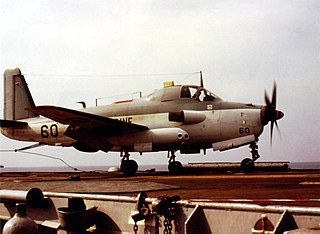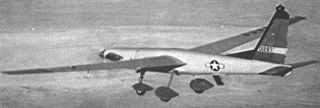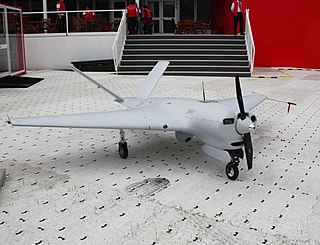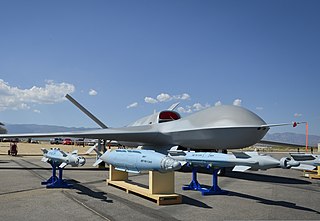Related Research Articles

The Sikorsky Cypher and Cypher II are types of unmanned aerial vehicles developed by Sikorsky Aircraft. They are vertical takeoff and landing aircraft which use two opposing rotors enclosed in a circular shroud for propulsion.
Hunter-Killer is an unofficial project name based upon an Aviation Week & Space Technology article. The U.S. Air Force's Hunter-Killer program was a tactical unmanned combat air vehicles (UCAV) procurement program. The General Atomics MQ-9 Reaper, a variant of the MQ-1 Predator won the project and was deployed in Afghanistan.

The Dragon Eye Unmanned Aerial Vehicle is a small reconnaissance Miniature UAV developed by the Naval Research Laboratory and the Marine Corps Warfighting Laboratory for use by the U.S. Marine Corps.

The Bréguet Br.1050 Alizé was a French carrier-based anti-submarine warfare aircraft. It was developed in the 1950s, based loosely on the second prototype Bréguet Vultur attack aircraft which had been modified into the Bréguet Br.965 Épaulard anti-submarine warfare aircraft.
Multiple battlefield UAVs, unmanned aerial vehicles for battlefield use, are operational in countries around the world, with more in development.

A miniature UAV or small UAV (SUAV) is an unmanned aerial vehicle small enough to be man-portable.
The BAI Aerosystems (BAIA) BQM-147 Dragon unmanned aerial vehicle is a tactical battlefield UAV operated by the US Marine Corps.

The Northrop Grumman Bat is a medium-altitude unmanned air vehicle originally developed for use by the United States Armed Forces. Designed primarily as an intelligence "ISR" gathering tool, the Bat features 30 lb payload capacity that is unmatched in a 10 ft wing span.

The General Atomics MQ-1C Gray Eagle is a medium-altitude, long-endurance (MALE) unmanned aircraft system (UAS). It was developed by General Atomics Aeronautical Systems (GA-ASI) for the United States Army as an upgrade of the General Atomics MQ-1 Predator.
The Skyblade is a man-portable mini-UAV developed by ST Aerospace, designed to be used by two operators for short-range battlefield or tactical reconnaissance and artillery spotting.

The BAE Systems HERTI is an unmanned aerial vehicle (UAV) developed by the British company BAE Systems. HERTI stands for "High Endurance Rapid Technology Insertion" and was developed in Warton, United Kingdom. The HERTI airframe is based on the J-6 Fregata motor glider designed by Jaroslaw Janowski of J&AS Aero Design, Poland. Its first flight was in December 2004 at the Australian Woomera test range where much of the test flight programme has been undertaken. HERTI was also the first UAV to fly in the UK with the flight being certified by the Civil Aviation Authority.

The BAE Systems SkyEye is a reconnaissance UAV developed in the United States in the early 1970s by Developmental Sciences Inc, later called Developmental Sciences Corporation, a division of Lear Astronics Corporation and ultimately part of BAE Systems. Developmental Sciences Inc was one of the first US companies to investigate battlefield UAVs, flying the first prototype of the SkyEye series in 1973, leading to the first flight of the improved R4E variant in 1981. The R4E has been continuously refined since then in a sequence of subvariants.

The Ling-Temco-Vought XQM-93 was a remotely piloted aircraft developed in the United States in the late 1960s and early 1970s for use as a communications relay in the Vietnam War. A prototype flew in 1970, but the program was abandoned without producing a service-ready aircraft.

The DRS Sentry HP is a reconnaissance UAV that was developed in the United States in the late 1980s by S-TEC. The program was acquired by Meggitt in 2000 and subsequently by DRS in 2002. Although the aircraft shares the name "Sentry" with a previous S-TEC design, the Sentry HP is a completely different machine, with a broad wing and a V tail. The Sentry HP is larger, with greater payload capacity and an underwing stores capability. It is powered by a variant of the same engine as the Sentry. It can be ordered with an option for fixed landing gear to permit conventional takeoff and recovery.
The Freewing Scorpion is a reconnaissance UAV of unusual design developed in the United States in the early 21st century by a company associated with the University of Maryland, College Park, Freewing Aerial Robotics Corporation. Working with well-known small-aircraft designer Burt Rutan, Freewing designed a series of piston-powered short-takeoff-and-landing UAVs, based on a design where the fuselage pivots relative to the wing surfaces. The "freewing" design also allows the UAV to operate as a stable observation platform during turbulent conditions.
The Mirach 150 is a reconnaissance unmanned aerial vehicle (UAV) developed in Italy in the 1990s. A turbojet-powered machine, it is apparently a derivative of the Mirach 100 series of targets, being of the same general size and also powered by a Microturbo TRS-18-1 turbojet.

The General Atomics Avenger is a developmental unmanned combat air vehicle built by General Atomics Aeronautical Systems for the U.S. military.
The Orion is a Medium-altitude long-endurance unmanned aerial vehicle (UAV) developed by Aurora Flight Sciences.

The Cloud Shadow, is an unmanned aerial vehicle of the High-Altitude Long Endurance (HALE) type, featuring an stealthy air-frame. As of 2017 it is being developed by the Chengdu Aircraft Industry Group for reconnaissance and precision strike missions.
References
This article contains material that originally came from the web article Unmanned Aerial Vehicles by Greg Goebel, which exists in the Public Domain.